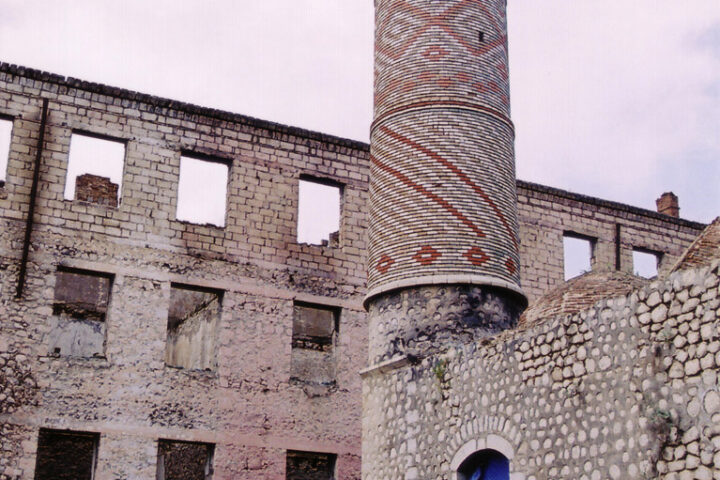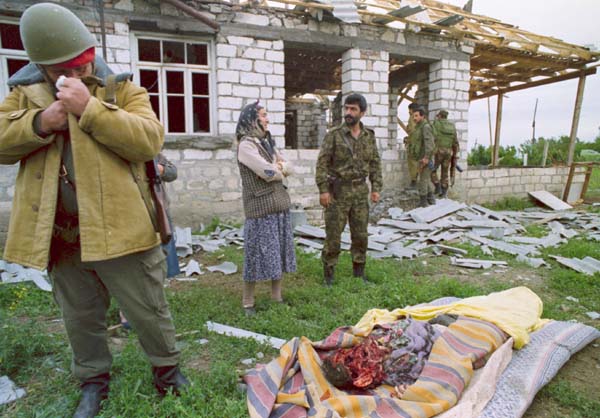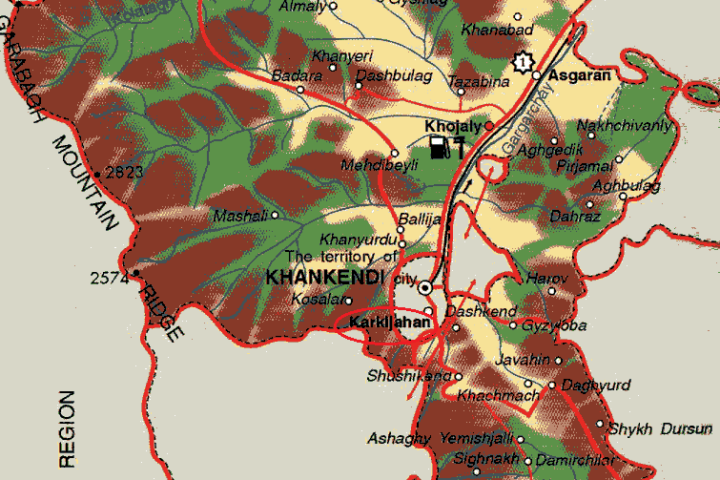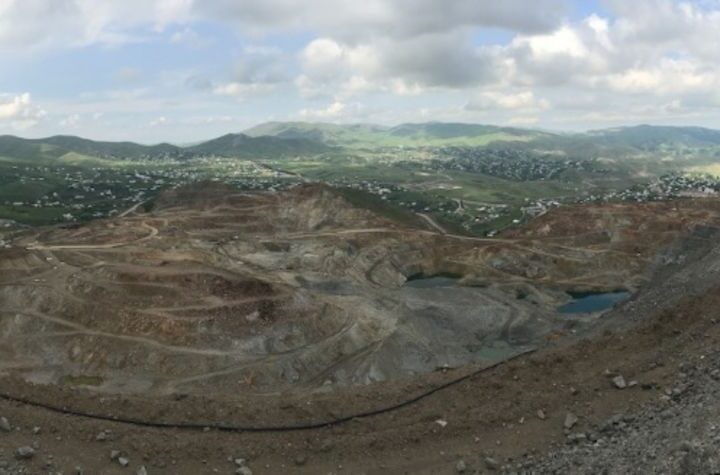Armenia and separatists develop their activity on occupied territories in the following directions:
1. Efforts to introduce a separatist-terrorist regime as an independent state
The separatist regime of Nagorny Karabakh took the advantage of the ceasefire regime and for the purpose of introducing themselves as an independent state, established a number of the “state institutions” (“Parliament”, “ministries”, “army”, “committee” and “institutions”) and opened its representative offices in a number of countries. In March of 2001 the people residing in this region were issued new passports, certifying their citizenship of Armenian Republic and false regime.
2. State terrorism and aggressive separatism
From 1989 to 1994, Armenian separatists and terrorists committed 373 terrorist acts in the territory of Azerbaijan. These resulted in 1,568 people killed and 1,808 were injured. The courts of the Azerbaijan Republic and foreign countries proved in a processual order that 32 out of 373 terrorist acts were commited with direct involvement of Armenian intelligence, which used the occupied Azeri lands for damaging settlements 100 kilometers away from the front line.
Armenian state bodies and separatist regime attempted to organize, finance and commit terrorist acts targeting Azerbaijani civilians, using the citizens of the third countries, representatives of national minorities of Azerbaijan and armed hostages and prisoners.
As a result of the fruitful cooperation between the Ministry of Defense of the Azerbaijan Republic and Federal Defense Agency of Russia, a group of Armenian separatists operating in the territory of Russia and led by colonel Djan Ohanesyan, chief of department of the Head Bureau of Defense, his deputy major Ashor Qaloyan, Major Boris Simonyan, attorney of the Agency for combat with terrorism under the secret service of Russia, was brought to trial. This group, financed by the TIRR association, which operates in Moscow under the leadership of Valeri Petrosyan, made a number of explosions of the railway carriages in Russia and Azerbaijan. All these persons were sentenced to different terms of imprisonment by the courts of the Azerbaijan Republic and Russian Federation.
An explosion committed at one of the Baku subway stations by members of a Russian terrorist organization Sadval operating in Daghestan on March 19th 1994 and resulting in 14 civilians killed and 42 injured was proven to be organized by the Armenian intelligence. The evidences of numerous witnesses and material evidences testified that those militants were trained at the military training bases of the special services, locating in Nairi and Arzni districts of Armenia and special camps, established in Meherremkend district of Daghestan.
The special services of Armenia financed and provided the criminals with necessary explosive materials and techniques for the commitment of the terrorist acts. The defense bodies of the Azerbaijan Republic ascertained 43 organizers and executors of the crimes, of them 30 were sentenced to imprisonment by the verdict of the Supreme Court of Azerbaijan, while the tracing of those hiding beyond the bounds of the country is still going on.
The singularity of the terrorist acts lies in the fact that special services of neighbor Armenia, supporting the separatist regime of Nagorny Karabakh, selected the terrorists for committing the acts among separatists of Russian Federation claiming for a number of northern regions of our country. This proves the fact that the interaction between separatists of different ethnic groups constitutes the international terrorism.
Unfortunately, this is not a single case. Thus, a group, aiming to launch a separatist movement in the name of Avars, living on the north of our country, activized in the early 2000. The situation in Zaqatala and Belakan was deteriorated by repeated attacks on the posts of the state road police, police stations and military units, explosion of the Sheikh Shamil monument in June of 2001.
The investigation revealed that the leader of the group Haji Magometov and later his imprisoned associate Shaban Bushdiyev had relations with representatives of Armenian special services.
Both of them visited Yerevan and Khankendi in 1997 to discuss the delivery of 1,000 guns and USD 1 million to them for the establishment of the Avar state in the territory of Azerbaijan. Later they continued their talks in Makhachkala and as a result they agreed on delivery of 1,000 guns and USD 300,000.
Then H.Magometov returned to Yerevan to enlist the support to the idea of establishment of Djar-Belekan state by avar separatists and their activity in this direction in December, 2001. The visit aimed to get various kinds of arms, including thermal missiles for occupation of the residence of new executive authorities, taking hostages among officials for releasing the imprisoned brothers-in arm and other crimes against the government.
The interrogation of persons, attempting to take the control over residents of Zaqatala district and to turn the area into an uncontroable one through different criminal actions, revealed that the “Minister of Defense”, and other state officials of the false separatist regime of Nagorny Karabakh, supplying arms and financial aide to separatists involved them into separatist movements.
A terrorist act, committed at the Baku underground stations 28th of May and Gendjlik on July 1994 and causing death to 13 people and wounding 42 civilians, was also organized by the special services of Armenia. For these purpose the mother of Azer Aslanov, captivated during military actions was deceived and called to Yerevan, then brought to the occupied Azeri areas and kept hostage there thus obliging A.Aslanov to commit the crime. (This fact was reflected in the book “Between Hell and Paradise” by Zori Balayan, one of the ideologists of nationalist-separatist extremism, currently wanted by Interpol).
The investigation and court trial proved that A.Aslanov’s indeological training as a terrorist was participated by working president of Armenia Robert Kocharyan, then leader of Armenian separatists of Nagorny Karabakh and Zori Balayan.
In the beginning of 1990th the Armenia leadership acting for rehabilitation of the terrorist groups’ leaders launched a large-scale compaign for assembling the radical organizations of foreign Diasporas as Dashksutyun, ASALA, MAQ, Armenian Association, Armenian Front of Freedom and other terrorist organizations in Armenia and created conditions for their activity, granted asylums and provided them with money, arms, false passports and transport means.
At the same time a number of foreign countries supplied guns and money to regions of Azerbaijan mainly inhabited by Armenians and provided for the release of Asmenians, committing terrorist acts against representations of Turkeyand even supported Armenian’s on the governmental level. Thus, the special service of Armenia conducted the campaign of signatures by the funds of Echmiadzin church for release of Varujan Karapetyan, native of Syria, member of ASALA, committing an explosion at Orli airport of France in June, 1983.
Released Monte Melkonyan, US resident, imprisoned for committing terrorist acts in France and world-famed terrorist was sent from Armenia and Nagorny Karabakh and headed the terrorist groups, driving Azerbaijanis of their native lands in 1990. The funerals of M.Melkonyan, killed by Azerbaijani troops were attended by senior officials of Armenia, later this world famed terrorist was attached the title of the national hero of Armenia and one of the diversion centers of Armenia Defense Ministry bore his name.
Vazgen Sislyan, sent to Khankendi in 1992, together with terrorists of Near East Abu Ali, Qilbert Minasanyan and others used the policy of violence to attact the attention of world community to the problems of Armenia.
After R.Kocharyan came to power the rehabilitation of the leaders of Armenian terrorist groups intensified with a new energy. Qrant Markaryan, the famous terrorist, citizen of Iran and Dashnaksutyun party member was released from prison and deserved the hero of Karabakh war by R.Kocharyan for his active participation in terrorist acts against Azerbaijan along with Vazgen Sislyan, one of organizers of Turkish embassy occupation in Paris in 1981.
These facts once more prove the direct participation of Armenia leadership in terrorist acts against Azerbaijan. In fact, the current leaders of Armenia president R.Kocharyan, Minister of defense S.Sarkisyan and leader of separatist regime in Nagorny Karabakh A.Qukasyan do not conceal their close relations with terrorists.
The frontier of occupied lands of Azerbaijan is guarded by military forces of Armenia and the conscripts of this country are sent to serve in the military bases of those areas. At the same time along with military troops and terrorist groups of Armenia a number of illegal military units also operate in occupied Azeri lands and this process is not controlled by the international convention for combact with terrorism.
3. Illegal drug production and trafficking
The occupied lands turned to a specific source of crime, not controlled by any international organization or state. Thus, the separatist regime created all necessary conditions for illegal cultivation, manufacture and sales of drugs in these areas. These facts were reflected in a report of March, 2000 on a control strategy of narcotic substances of the US Department of State. Drug dealers supported mean leaders of the false regime and used the profits from the drug sales for retaining control over the occupied lands and paying wages to employees.
A report of the US Department of State March 2001 testifies the use of occupied Azeri lands for mass cultivation of narcotic substances and regards Armenia as a potential establishment in the international circulation of drugs.
The fact of hamp bushes cultivation on the occupied Azeri lands is also reflected in the report of the US Department of State devoted to Nagorny Karabakh.
Separatists use most part of funds received from drug sales for acquisition of guns for military units and terrorist groups and conduction of trainings. Illegal economic activity of Nagorny Karabakh and separatists famous for their activity in money-laundering became the object of interests of transnational criminal structures.
The occupied lands are also suspected to use for intering nuclear and radioactive waste. Thus, the absence of warehouse for keeping nuclear waste under the Metsamow Atom Electric Station, producing 9 million KW-Hs of energy suggests that the occupied lands are utilised for this purpose.
4. Human trafficking
As a result of Armenia’s invasion to the Azerbaijan Republic, citizens of Azerbaijan taken hostages or imprisoned were kept in the occupied lands secretly from international humanitarian organizations and were subject to cruel methods of punishment and were used for uncivil purposes.
Some incontrovertible evidences prove that the Armenian officials, trying to make use of consequences of aggression against Azerbaijan and existing status-quo, turning those Azerbaijanis, taken hostages and prisoners into the trading article, established cooperation with different criminal organizations.
The relatives of 30 people, taken hostages and imprisoned in periods of war and ceasefire released them by giving great amounts of money, gold and valuable things. The parts of bodies of most citizens taken hostages were removed and sold.
The citizens of the Azerbaijan Republic, tkan hostages and imprisoned are kept on the occupied lands and are applied the violents punitive measures.
5. Illegal settlement of Armenians on the occupied lands
According to the report of the self-proclaimed government of Nagorny Karabakh and official information of Armenia, the population of Nagorny Karabakh equaled 143,000 people in 2001. However, by the 1989’s census enumeration a bit more than 90 thousand of Armenians lived in that region.
A report on Armenia of the global review of 2002, on the state of refugees of the US committee for refugees stated that nearly 1000 families were driven out from Armenia to Nagorny Karabakh and Lachyn.
To prevent people from leaving Nagorny Karabakh, definite rules were introduced, according to which those intending to move from the region forever would have to pay the sum of USD 15 thousand and military conscripts-USD 10 thousand beginning from 2001.
The migration services officially operating in all cities and districts of Armenia from 2002 are directing their activity for the resettling the country population to the occupied lands. The year of 1994 is marked for cases of illegal resettling the Armenians residing abroad to Nagorny Karabakh and the occupied lands. The “parliament” of the false regime also carried out decisions stipulating for the children from Russian families, moved to Nagorny Karabakh to educate in Karabakh schools in Armenian and Russian languages beginning from 2005.
According to the estimate of the Mission for Migration in the South Caucasus of the international Committee of the Red Cross of 25 October 2004, on average nearly 15 families are moved every year to Nagorny Karabakh and in 2004 the number of the families amounted to 200.
Though official Yerevan consealed its direct participation in the migration projects, yet the large-scaled migration program ” Return to Artszakh” involved Benik Bakhshivan, attorney of the Armenia government (headed by Andranik Margaryan), Serj Amirkhanyan, chief of “the statistical committee” of “the Republic of Nagorny Karabakh”, Vaqram Baqdasaryan – “Minister of Agriculture”, Major Danelyan – “chair of the commission for budget and financial issues of the National Assembly”, Qaqik Eqalyan – head of Armenian department for refugees and migration and other officials, including the public organisation Yerkir. From that time the department for refugees and emigration took a direct part in the implementation of the above mentioned program.
In December of 2003 the Prime Minister of Armenia A.Margaryan officially announced that the resettlement of Armenians to the occupied lands of Azerbaijan is the priority issue for Armenian government.
The illegal settlement on the occupied lands was lightened in a number of Mass Medias. According to the open announcements, within the first six months of 2004 120 Armenian families were settled on the occupied lands.
The illegal resettlement and building operations were sponsored by the Fund of Armenian Education of West America, Hayastan Fund and the Council of Armenian Eparchy of Teheran. It’s also known that foreign funds allotted USD 400 thousand for the implementation of the program “Return to Artsakh” and the construction of nearly 90 houses was completed in occupied Azeri lands in 2004.
The information on the adoption of funds, stipulated for the program implementation by some authorized persons and the the return of 30% of resettled population to Yerevan and other UN member-states due to the lower living standards was reflected in a number of Armenian mass medias in 1999. One of these cases was the publishing of an article “State budget does not have funds for persons resettled to Nagorny Karabakh” by Vaqram Oqanesyan in 1999 in 10th nakhanq newspaper on the non-delivery of funds to the families residing and resettled to Nagorny Karabakh. The article caused the imprisonment of V.Oqacanyan for the term of a year in 2000 and promoted the institution of criminal proceeding by the presecutor’s office of Nagorny Karabakh.
6. Despoilment of natural, material and cultural reserves and their illegal utilization
Armenian separatists destruct the houses, graves, cultural monuments, and carry out equipments, building materials especially iron and other cargoes to other countries.
A number of sources announce that Armenians transport valuable metals, including soil, containing gold, machines, produced at plants and factories, electric carriages and cut rails to other countries.
Armenians introduce the national reserves, robbed from the occupied Azeri lands, including ancient historical works, carpets and minerals, to Europen as a national wealth of Armenian people. Armenians presented the mineral deposits of Kelbadjar and the pictures of nearly 3600 rock paintings as those locating at their own territory in Finland 2000.
Armenians have recently introduced ancient musical instruments of Azerbaijan as their own in European, UN and North Americal countries and sell them, the cases when Armenians sold Karabakh carpets, introducing them as Armenian and Persian ones have also been registered. Numerous historical, cultural and religious monuments, robbed from the occupied Azeri lands, have been sold to foreign countries.
The unique exhibits of the museums, locating in the occupied Azeri lands were either destroyed or used as a basis of new museums, as if certifying their belonging to Armenians. Armenians attach a great importance to the adaptation of the monuments of ancient Caucasus Albania. The ancient Albanian scripts, wall designs and crosses were replaced by Armenian attributes. A number of mosques are used as store-houses.
This campaign aimed to prove that the occupied lands are not the historical parts of Azerbaijan thus justifying Armenian’s settlement on them. For this purpose the Azerbaijani names of the settlements were largely replaced by Armenian names. That aimed to provide for the further annexion of the territories to Armenia.
Armenians attracted a number of foreign organizations and firms to the illegal economic activity on the occupied lands to widen the robbery of material riches of oul people. In January-July 2004 Armenians initiated the visit of 1610 foreign citizens to Nagorny Karabakh without permission of the authorized state bodies of the Azerbaijan Republic.
The data, obtained by the Ministry of Defense on the illegal activity of separatist regime and Armenia on the occupied lands of the Azerbaijan Republic out of control of the international community.







